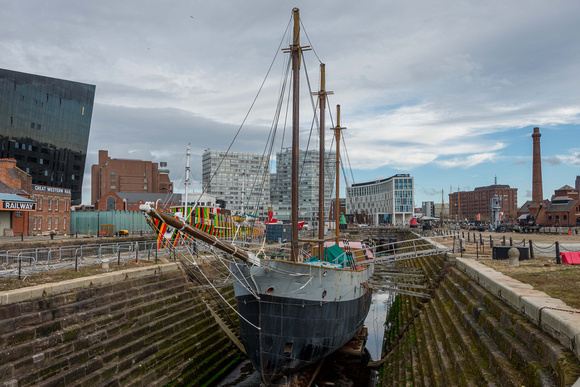De Wadden - A Three Masted Schooner built 1917 by Gebr van Diepan, Waterhuizan, Netherlands
DE WADDEN is a three-masted auxiliary schooner built in the Netherlands in 1917. She was built by Gebr Van Diepen of Waterhuizan, Netherlands, for the Nederlandsche Stoomvaart Maatschappij (Netherlands Steamship Company). This company commissioned DE WADDEN and her two sisters in order to take advantage of the very lucrative trading conditions created by Dutch neutrality in the First World War, and it is vessels like her which provided the foundation for the continuing Dutch strength in the European short-sea trades. The world-wide shipping slump in the early 1920s forced her sale to Richard Hall of Arklow in the South of Ireland, and it is as an Irish Sea schooner that she is best remembered. From 1922 to 1961, DE WADDEN carried bulk cargoes such as grain, pit-props, china clay, mineral ores, and especially coal from the River Mersey to various Irish ports. Victor Hall, her longest serving Captain, commanded her from 1933 to 1954, and her finest hour was probably during the Second World War when she was one of a small handful of vessels which provided the vital lifeline of supplies to the Irish Republic, after many other ships had been taken up for the British war effort. Her crew consisted of only five men and a boy, and since she could sail, a qualified marine engineer was not required. She carried a motor winch in the forward deckhouse to allow the cargo to be handled without extensive shoreside facilities. The motor was used almost all the time when she was under sail. This allowed the motor schooner to be built with a flat bottom and shallow draught for maximum cargo capacity together with the ability to enter small harbours. Without the push of the motor, this hull shape does not sail very well. Her original 125 hp 'SteyWal Dutch engine gave her a speed of five knots, but after a major failure was replaced by an 80hp Bolinder engine purchased from the Admiralty. In addition a 50 hp Kelvin engine was fitted on the port quarter to give additional power. These were both removed in January 1942 and replaced with a sic cylinder 150 hp Crossley DR diesel which was only replaced in turn by a 450 hp Caterpillar Diesel in 1980. This combination of sail and motor remained economical up to the early 1960s when she finally had to retire in favour of a modern motor coaster. She was therefore sold in Dublin to Mr McSweeney who took her to Scotland for a new and varied career. Her tasks ranged from carrying sand to taking out fishing parties, and she even appeared in a number of films, including The Onedin Line for the BBC. She was eventually put up for sale by her last owner, Kenneth Kennedy of Dunoon, and purchased by the Merseyside Maritime Museum in 1984. In 1987 she was drydocked to allow an extensive program of conservation and restoration. In the early 1990s the Museum briefly ran some onboard tours and education sessions, before this was withdrawn to allow further necessary conservation work to take place. Since then conservation has been ongoing to stabilise her and she has continued to be drydocked next to the Liverpool Pilot Cutter, EDMUND GARDNER.


